





When the hot, dry days of summer test the tender plants in our gardens, these hardy specimens will keep color in your landscape well into fall.
(Editor's Note: This article was originally published on November 25, 2008. Your comments are welcome, but please be aware that authors of previously published articles may not be able to respond to your questions.)Gardeners in the southern portion of the United States, and possibly other parts of the world, will probably be familiar with some of the durable, almost indestructible shrubs that flourish with little water, high temperatures, dry air, and little or no attention. For those of you who battle these mid-summer conditions, satisfy your garden palate with long-lasting color.
Butterfly Bush (Buddleia davidii) is a favorite everywhere, with its soft green leaves, wonderful array of bloom color, and delightful fragrance (usually in the evening). This zone 5b to 10b shrub needs full sun. It grows quickly and can come back for several springs. It is, however, one of those plants that sometimes dies for no reason. Bloom begins in mid-summer, continuing through late fall.
Carolina Allspice (Calycanthus floridus) is fragrant and does well in Zones 4b to 9b. The fragrance has been described as fruity. Bloom begins in late spring through late summer.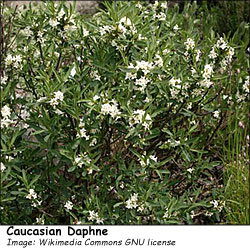
Caucasian Daphne (Daphne caucasica) is a lesser known cousin of the famous fragrant Daphne of our grandmothers' gardens. Hardy in zones 5 to 8, caucasian daphne's white flowers are highly fragrant. This shrub blooms in midsummer and continues through the fall months, sometimes until the first hard frost. Well-drained soil and full to partial sun are all this hard-worker needs.
Crepe Myrtle (Lagerstroemia indica) actually needs the heat. It prospers in zones 7 to 10. For in-depth information on this wonder shrub, read Aunt-A's excellent article, "Crepe Myrtle: Summer Survivor."
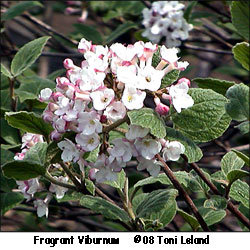
Doublefile Viburnum (Viburnum plicatum f. tomentosum) boasts pure white flowers against velvety leaves. Bloom begins in late spring and
continues into fall, often as late as October in zones 5b to 9. Vibu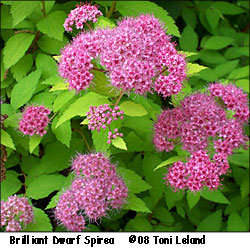 rnum can grow to large proportions with partial or full sun and reasonably fertile soil.
rnum can grow to large proportions with partial or full sun and reasonably fertile soil.
Dwarf Spireas (Spirea spp.) are virtually non-stop bloomers from late spring through late summer in zones 4a to 8b. Beautiful pink or magenta blooms on almost neon green leaves make this a fabulous easy-care shrub for any landscape.
Glorybower (Clerodendrum trichotomum) is another shrub with brilliant white, heavily perfumed flowers which open in mid-summer. By August or September, the blooms are replaced with dark blue berries which eventually turn black. Zones 6 to 9 are best for this shrub, which requires ample sun and well-drained soil.
Japanese Kerria (Kerria japonica) needs a half day or more of sun, and the bright yellow blooms work well in a partially shaded garden. For Zones 3a to 10b, bloom begins in mid-spring and continues until first frost.
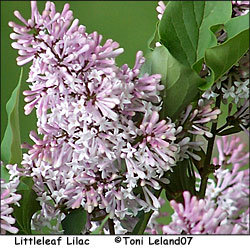 Littleleaf Lilac (Syringa microphylla) is the black sheep of the lilac family, boasting a re-blooming habit that keeps the landscape alive with pinky-lavender blooms from late spring through late summer. The scent is true lilac and quite noticeable at dusk. In Zones 5 to 9, this
Littleleaf Lilac (Syringa microphylla) is the black sheep of the lilac family, boasting a re-blooming habit that keeps the landscape alive with pinky-lavender blooms from late spring through late summer. The scent is true lilac and quite noticeable at dusk. In Zones 5 to 9, this 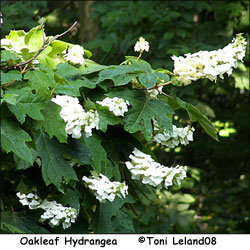 shrub is tolerant of most soil and light conditions.
shrub is tolerant of most soil and light conditions.
Oakleaf Hydrangea (Hydrangea quercifolia) explodes with white flowers in June, then continues through the summer months, the blossoms aging to purple and parchment tones against the darkening leaves as fall arrives. This shrub is hardy in zones 5b to 10, and does well in richly organic soil. It likes either sun or shade, making it a perfect plant for almost any spot.
Potentilla (Potentilla spp.) is a landscape workhorse, blooming in several shades from gold to red. Early spring trimming to keep the shrub compact will add to the length of bloom time. Hardy in zones 2a to 8b.
Summersweet (Clethra alnifolia) is also a heavily fragrant bloomer for zones 3b to 9b. Flowers are either pink or white. The shrub needs moist, somewhat acidic soil. Bloom begins in late spring and continues through early fall.
Start thinking now about how you'll extend the color season in your garden.
Wikipedia: GNU Free Documentation License
Copyright © www.100flowers.win Botanic Garden All Rights Reserved